Search results for "Riikka"
Riikka Pelo: Jokapäiväinen elämämme [Our everyday life]
13 June 2013 | Mini reviews, Reviews
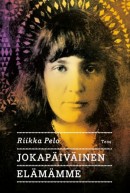 Jokapäiväinen elämämme
Jokapäiväinen elämämme
[Our everyday life]
Helsinki: Teos, 2013. 526 p.
ISBN 978-951-851-389-9
35.90€, hardback
At the centre of Riikka Pelo’s second novel are the Russian poet Marina Tsvetaeva (1892–1941) and her daughter Ariadna Efron (1912–1975). This broad historical novel depicts the mental landscape of Russia during the period between the two great wars, from the 1920s to the 1940s. The mother is a religious believer and idealist, her daughter a more pragmatic empiricist. The family’s fate is controlled by the Soviet state apparatus, which sends it into exile in Paris where Tsvetaeva’s husband Sergei Efron takes a job as a secret police informer in an organisation devoted to the repatriation of Soviet emigrés. In the 1930s they return to Moscow, where life under the watchful eye of Stalin is filled with difficulty and paranoia. Pelo portrays the awkward relationship between mother and daughter with particular vividness. The indisputable star of the family is the mother – her ambition extends to her daughter, who to her disappointment is more interested in the visual arts than in poetry. The historical characters of Pelo’s impressive novel live their contradictory lives in decades of social upheaval.
Translated by David McDuff
Riikka Pulkkinen: Totta [True]
22 October 2010 | Mini reviews, Reviews
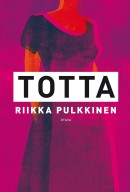 Totta
Totta
[True]
Helsinki: Otava, 2010. 333 p.
ISBN 978-951-1-22965-0
€ 31,40, hardback
The second novel by Riikka Pulkkinen (born 1980) is a comprehensive work that tackles big themes: love, death and rejection. Pulkkinen’s particular strengths as an author are her richly nuanced language and her mastery of structure. While the ending provides food for thought, the book is an enjoyable novel about childhood, growing up, daring to love and live. Martti, a seventy-year-old artist, is caring for his sick wife, a highly respected psychologist. Martti and Elsa have had a long and happy marriage. Then it emerges that Martti had a long affair with their live-in childminder Eeva, whose story grows into one of the main plot strands of the book. Their love story takes place against the background of the 1960s, when the waves passing through European society reached Finland as well. Pulkkinen skilfully brings the perspective of the now grown-up daughter Eleonoora into the mix, as she views her early childhood under the care of two mother figures. At the 2010 Frankfurt Book Fair translation rights to Totta were sold to six countries, which at least goes to show that there is interesting literature to be found in the Nordic countries beyond the ubiquitous crime novels.
And the winner is…?
27 March 2012 | This 'n' that
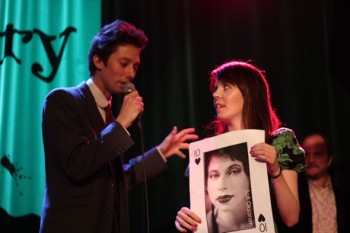
Playing your cards right: Todd Zuniga talks to Riikka Pulkkinen on 20 March in Helsinki. Photo: courtesy/T. Zuniga
The writer Johanna Sinisalo’s words lash the stage like the tail of Pessi the troll in her best-known novel. The novelist Riikka Pulkkinen bursts into deconstructive dance. The singer Anni Mattila translates the poet Teemu Manninen’s explosive poetic frolics into rhythmic dictations and the Finlandia Prize-winning author Rosa Liksom’s conductor’s glittering moustaches see the audience off on a train journey to Moscow.
On a March evening, a Literary Death Match has begun in the Korjaamo Culture Factory in Helsinki’s old tramsheds. The creation of the American author and journalist Todd Zuniga, the Literary Death Match combines an evening of readings with stand-up comedy as well as the judging familiar from reality TV shows.
‘It all started with me eating sushi with two of my friends and talking about some of the readings we’d been to. We all loved literature and loved to listen to writers reading from their own work. But the audience was always the same circle of people. We wanted to expand it beyond literary circles,’ Zuniga explains. More…
The private I? Me and my home
17 June 2014 | Reviews
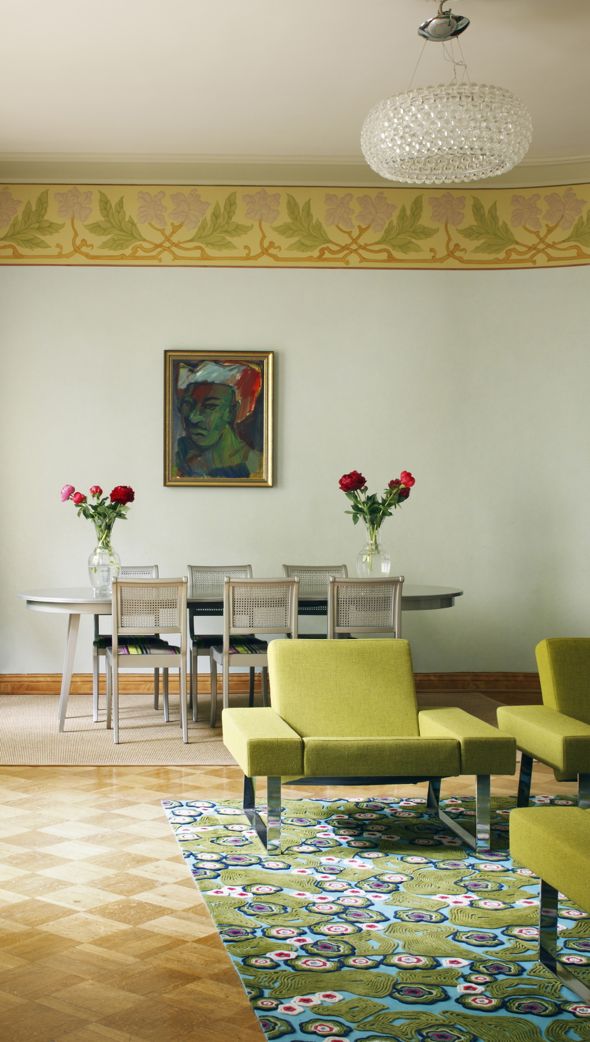
Art Nouveau with a modern twist. Photo: Avaimia ajattomiin suomalaisiin sisustuksiin / Jaanis Kerkis
Avaimia ajattomiin suomalaisiin sisustuksiin
[Keys to timeless Finnish interiors]
Design: Hanni Koroma, text: Sami Sykkö, photographs: Jaanis Kerkis
Helsinki: Gummerus, 2014. 123 pp., ill.
ISBN 978-951-20-9507-0
€32.90, hardback
Katja Lindroos
MOMO. Koti elementissään
[MOMO. The home in its element]
Photography: Riikka Kantinkoski, Niclas Warius
Helsinki: Siltala, 2013. 154 pp., ill.
ISBN 978-952-234-164-8
€32.90, hardback
www.momokoti.fi (in Finnish only)
‘Interior decoration’ has become an extremely popular pastime in Finland – as elsewhere where the standard of living allows it.
Innumerable magazines and blogs keep churning out photos of rooms with large white, cushioned sofas, glossy white kitchen cabinets and white floors on which furniture seems to float forlornly. Walls are decorated with wooden or metallic letters forming words: love; home, sweet home. In the kitchen the bread bin bears the word BREAD. (Bookcases, with actual books, are rare.)
Why is it that in our age which worships ‘individuality’, trends rule? More…
The Finlandia Prize for Fiction 2013
5 December 2013 | In the news
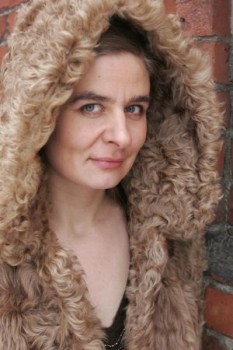
Riikka Pelo. Photo: Heini Lehväslaiho
The director general of the Helsinki City Theatre, Asko Sarkola, announced the winner of the 30th Finlandia Literature Prize for Fiction, chosen from a shortlist of six novels, on 2 December in Helsinki. The prize, worth €30,000, was awarded to Riikka Pelo for her novel Jokapäiväinen elämämme (‘Our everyday life’, Teos).
In his award speech Sarkola – and actor by training – characterised the six novels as ‘six different roles’:
‘They are united by a bold and deep understanding of individuality and humanity against the surrounding period. They are the perspectives of fictive individuals, new interpretations of the reality we imagine or suppose. Viewfinders on the present, warnings of the future.
‘Riikka Pelo‘s Jokapäiväinen elämämme is wound around two periods and places, Czechoslovakia in 1923 and the Soviet Union in 1939–41. The central characters are the poet Marina Tsvetaeva and her daughter Alya. This novel has the widest scope: from stream of consciousness to interrogations in torture chambers and the labour camps of Vorkuta; always moving, heart-stopping, irrespective of the settings.’
The five other novels were Ystäväni Rasputin (’My friend Rasputin’) by JP Koskinen, Hotel Sapiens (Teos) by Leena Krohn, Terminaali (‘The terminal’, Siltala) by Hannu Raittila, Herodes (‘Herod’, WSOY) by Asko Sahlberg and Hägring 38 (‘Mirage 38’, Schildts & Söderströms; Finnish translation, Kangastus, Otava) by Kjell Westö (see In the news for brief features).
Human destinies
7 February 2014 | Articles, Non-fiction
To what extent does a ‘historical novel’ have to lean on facts to become best-sellers? Two new novels from 2013 examined
When Helsingin Sanomat, Finland’s largest newspaper, asked its readers and critics in 2013 to list the ten best novels of the 2000s, the result was a surprisingly unanimous victory for the historical novel.
Both groups listed as their top choices – in the very same order – the following books: Sofi Oksanen: Puhdistus (English translation Purge; WSOY, 2008), Ulla-Lena Lundberg: Is (Finnish translation Jää, ‘Ice’, Schildts & Söderströms, 2012) and Kjell Westö: Där vi en gång gått (Finnish translation Missä kuljimme kerran; ‘Where we once walked‘, Söderströms, 2006).
What kind of historical novel wins over a large readership today, and conversely, why don’t all of the many well-received novels set in the past become bestsellers? More…
Fiat lux! Helsinki lit
9 January 2014 | This 'n' that
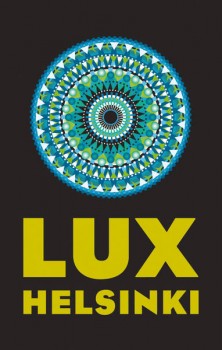 When there’s no snow in January, as is the case this year, the darkness does make Helsinki appear somewhat joyless. This year Canada and parts of the United States got more than a taste of freezing Arctic temperatures – but at the time of writing winter is still postponed in the lower half of Finland.
When there’s no snow in January, as is the case this year, the darkness does make Helsinki appear somewhat joyless. This year Canada and parts of the United States got more than a taste of freezing Arctic temperatures – but at the time of writing winter is still postponed in the lower half of Finland.
A temporary relief was brought by Lux Helsinki – staged now for the sixth time – as light, colour and sound made the capital brighter and more beautiful between 4 and 8 January.
The core of the city, the Cathedral, was adorned by a large heart placed at the top of the steps, beating in colours to music.

Corazón by Agatha Ruiz de la Prada. Photo: Marina Okras
Corazón, by the Madrid-born artist and fashion designer Agatha Ruiz de la Prada, in collaboration with the production and design company D-Facto, reflects her design themes of love and happiness.
One of the participants in Lux Helsinki was Unen ääret / Edges of Dreams: projected on to the façade of the Hakasalmi Villa (1843–46), between the Finlandia Hall and the Music House, it was inspired by the history of the building and its inhabitants. Now a museum, it became known as the home of a benefactor of the city, a rich and famous woman of her time, Aurora Karamzin from the 1860s to the 1890s.

Hakasalmi Villa: Edges of Dreams by Mika Haaranen. Photo: Lauri Rotko
The building was seen through dreamlike visions formed by painted films and shadow patterns by Mika Haaranen, a lighting and set designer and photographer. His works extend from the world of theatre and musicals to contemporary dance, concerts and film. The accompanying music was composed by Aake Otsala.
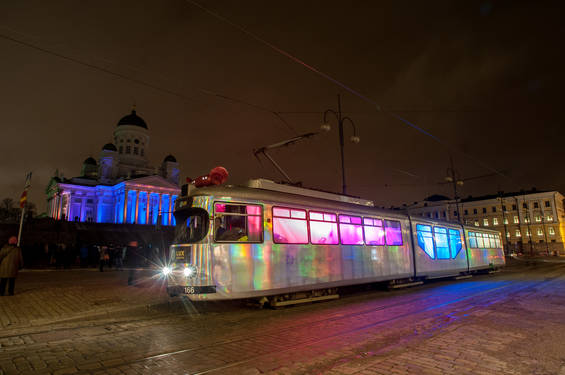
Lux Tram by students of lighting and sound design, Theatre Academy. Photo: Hannu Iso-Oja
Helsinki trams have been transporting citizens from 1891. One of the trams was transformed into a moving light installation by the use of programmable LED floodlights. The work was designed and realised by the Theatre Academy of the University of the Arts Helsinki lighting design students Riikka Karjalainen and Alexander Salvesen. A pity it was not possible to hop on…
Best-selling books in September
18 October 2012 | In the news
Number one on the September list of best-selling Finnish fiction titles, compiled by the Finnish Booksellers’ Association, is Sofi Oksanen’s new novel Kun kyyhkyset katosivat (‘When the doves disappeared’, Like): which shot straight to the top of the list on its publication in August.
The huge national and international success of her previous novel, Puhdistus – in English, Purge – published in 2008 and also set in Estonia, has paved the way for Kun kyyhkyset katosivat; translation rights have been sold to several countries already.
Number two on the list was Riikka Pulkkinen’s third novel, Vieras (‘The stranger’, Otava). In third and fourth places were two new thrillers, Paholaisen pennut (‘The devil’s cubs’, Tammi), by Leena Lehtolainen, and Ylösnousemus (‘Resurrection’, WSOY), by Ilkka Remes.
In fifth place was Sirpa Kähkönen’s novel Hietakehto (‘Sand cradle’, Otava): number six in her series set in the Kuopio region of eastern Finland, during the Second World War.
The non-fiction (translated foreign as well as Finnish) list was topped by Blaine Harden’s Escape from Camp 14 (in North Korea; Gummerus). The variety of subjects on this list can be surprising: number two is about angels (Lorna Byrne’s A Message of Hope from the Angels, Otava), number three a biography of a Finnish ex-con turned surgeon (Veitsen terällä, ‘On knife’s edge’, by Arno Kotro & Christer Lybäck, Otava), number four about the Cold War in Finland (Jukka Tarkka: Karhun kainalossa, ‘Under the arm of the bear’, Otava) and number five about cupcakes (by Angela Drake, Otava)…
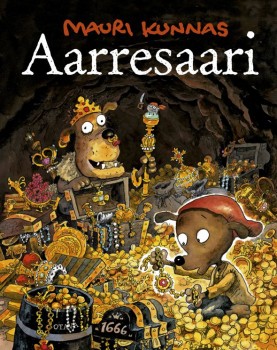
Mauri Kunnas: Aarresaari
The three best-selling children’s books were by seasoned Finnish authors: illustrator-writer Mauri Kunnas, with his tribute to R.L Stevenson, Aarresaari (‘Treasure island’, Otava), Aino Havukainen & Sami Toivonen, with Tatu ja Patu pihalla (‘Tatu and Patu outdoors’, Otava) and Sinikka Nopola & Tiina Nopola, with their Risto Räppääjä ja nukkavieru Nelli (‘Risto Rapper and Threadbare Nelly’, Tammi).
Finlandia Prize for Fiction candidates 2012
23 November 2012 | In the news
The candidates for the Finlandia Prize for Fiction 2012 were announced on 15 November. They are Riikka Ala-Harja, Pirjo Hassinen, Heidi Köngäs, Ulla-Lena Lundberg, Aki Ollikainen and Juha Seppälä.
Their novels, respectively, are Maihinnousu (‘The landing’, Like), Popula (Otava), Dora, Dora (Otava), Is (‘Ice’, Schildts & Söderströms), Nälkävuosi (‘The year of hunger’, Siltala) and Mr. Smith (WSOY).
The jury – researcher Janna Kantola, teacher of Finnish Riitta Kulmanen and film producer Lasse Saarinen – made their choice out of ca. 130 novels. The winner, chosen by Tarja Halonen, who was President of Finland between 2000 and 2012, will be announced on 4 December. The prize, awarded since 1984, is worth 30,000 euros.
The jury’s chair, Janna Kantola, commented: ‘One of this year’s recurrent themes is the Lapland War [of 1944–1945]. Writers appear to be pondering the role of Germany in both the Second World War and in contemporary Europe. Social phenomena are examined using satire; the butt is the birth and activity of extremist political movements. Economics, the gutting of money and market forces, are present, as in previous years, but now increasingly with a sense of social responsibility.’
Popula deals with people involved in a contemporary populist political party. Dora, Dora describes Albert Speer’s journey to Finnish Lapland in 1943. Nälkävuosi depicts the year of hunger in Finland, 1868. Is takes place in the Finnish archipelago of the post-war years. Mr. Smith portrays greed and the destructive power of money both in Russian and Finnish history as well as in contemporary Finland. Maihinnousu, set in Normandy, depicts a child’s serious disease in a family that is going through divorce.
Finland(ia) of the present day
2 December 2010 | In the news

Mikko Rimminen. Photo: Heini Lehväslaiho
The Finlandia Prize for Fiction 2010, worth €30,000, was awarded on 2 December to Mikko Rimminen (born 1975) ; his novel Nenäpäivä (‘Nose day’, Teos) was selected by the cultural journalist and editor Minna Joenniemi from a shortlist of six.
Appointed by the Finnish Book Foundation, the prize jury (Marianne Bargum, former publishing director of Söderströms, researcher and writer Lari Kotilainen and communications consultant Kirsi Piha) shortlisted the following novels:
Joel Haahtela: Katoamispiste (‘Vanishing point’, Otava), Markus Nummi: Karkkipäivä (‘Candy day’, Otava), Riikka Pulkkinen: Totta (‘True’, Teos), Mikko Rimminen: Nenäpäivä (‘Nose day’, Teos), Alexandra Salmela: 27 eli kuolema tekee taiteilijan (’27 or death makes an artist’, Teos) and Erik Wahlström: Flugtämjaren (in Finnish translation, Kärpäsenkesyttäjä, ‘The fly tamer’, Schildts). Here’s the FILI – Finnish Literature Exchange link to the jury’s comments.
Joenniemi noted the shortlisted books all involve problems experienced by people of different ages. How to be a consenting adult? How do adults listen to children? Contemporary society has been pushing the age limits of ‘youth’ upwards so that, for example, what used to be known as middle age now feels quite young. And, for example, in Erik Wahlström’s Flugtämjaren (now also on the shortlist for the Nordic Literature Prize 2011) the aged, paralysed 19th-century author J.L. Runeberg appears full of hatred: being revered as Finland’s national poet didn’t make him particularly noble-minded.
According to Joenniemi, Rimminen’s novel ‘takes a stand gently’ in its portrayal of contemporary life – in a city where a lonely person’s longing for human contacts takes on tragicomical proportions. Joenniemi finds Rimminen’s language ‘uniquely overflowing’. Its humour poses itself against the prevailing negative attitude, turning black into something lighter.
Rimminen has earlier published two collections of poems and two novels (Pussikaljaromaani, ‘Sixpack novel’, 2004, and Pölkky, ‘The log’, 2007) . Pussikaljaromaani has been translated into Dutch, German, Latvian, Russian and Swedish.
How much did Finland read?
30 January 2014 | In the news
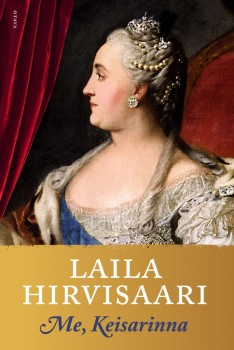 The book year 2013 showed an overall decrease – again: now for the fifth time – in book sales: 2.3 per cent less than in 2012. Fiction for adults and children as well as non-fiction sold 3–5 per cent less, whereas textbooks sold 4 per cent more, as did paperbacks, 2 per cent. The results were published by the Finnish Book Publishers’ Association on 28 January.
The book year 2013 showed an overall decrease – again: now for the fifth time – in book sales: 2.3 per cent less than in 2012. Fiction for adults and children as well as non-fiction sold 3–5 per cent less, whereas textbooks sold 4 per cent more, as did paperbacks, 2 per cent. The results were published by the Finnish Book Publishers’ Association on 28 January.
The overall best-seller on the Finnish fiction list in 2013 was Me, Keisarinna (‘We, tsarina’, Otava), a novel about Catherine the Great by Laila Hirvisaari. Hirvisaari is a queen of editions with her historical novels mainly focusing on women’s lives and Karelia: her 40 novels have sold four million copies.
However, her latest book sold less well than usual, with 62,800 copies. This was much less than the two best-selling novels of 2012: both the Finlandia Prize winner, Is, Jää (‘Ice’) by Ulla-Lena Lundberg, and the latest book by Sofi Oksanen, Kun kyyhkyset katosivat (‘When the doves disappeared’), sold more than 100,000 copies.
The winner of the 2013 Finlandia Prize for Fiction, Riikka Pelo’s Jokapäiväinen elämämme (‘Our everyday life’, Teos) sold 45,300 copies and was at fourth place on the list. Pauliina Rauhala’s first novel, Taivaslaulu (‘Heaven song’, Gummerus), about the problems of a young couple within a religious revivalist movement that bans family planning was, slightly surprisingly, number nine with almost 30,000 copies.
The best-selling translated fiction list was – not surprisingly – dominated by crime literature: number one was Dan Brown’s Inferno, with 60,400 copies.
Number one on the non-fiction list was, also not surprisingly, Guinness World Records with 35,700 copies. Next came a biography of Nokia man Jorma Ollila. The winner of the Finlandia Prize for Non-Fiction, Murtuneet mielet (‘Broken minds’, WSOY), sold 22,600 copies and was number seven on the list.
Eight books by the illustrator and comics writer Mauri Kunnas featured on the list of best-selling books for children and young people, with 105,000 copies sold. At 19th place was an Angry Birds book by Rovio Enterntainment. The winner of the Finlandia Junior Prize, Poika joka menetti muistinsa (‘The boy who lost his memory’, Otava), was at fifth place.
Kunnas was also number one on the Finnish comic books list – with his version of a 1960s rock band suspiciously reminiscent of the Rolling Stones – which added 12,400 copies to the figure of 105,000.
The best-selling e-book turned was a Fingerpori series comic book by Pertti Jarla: 13,700 copies. The sales of e-books are still very modest in Finland, despite the fact that the number of ten best-selling e-books, 87,000, grew from 2012 by 35,000 copies.
The cold fact is that Finns are buying fewer printed books. What can be done? Writing and publishing better and/or more interesting books and selling them more efficiently? Or is this just something we will have to accept in an era when books will have less and less significance in our lives?
Funny stuff: best-selling books in February
13 March 2014 | In the news
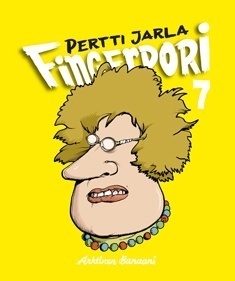 The list of best-selling books – compiled by the Finnish Booksellers’ Association – shows that in February comedy was popular among readers. Number one on the Finnish fiction list was Fingerpori 7 (‘Fingerborg 7’, Arktinen Banaani), the latest comics book by Pertti Jarla, featuring silly stuff taking place in the city of Fingerpori.
The list of best-selling books – compiled by the Finnish Booksellers’ Association – shows that in February comedy was popular among readers. Number one on the Finnish fiction list was Fingerpori 7 (‘Fingerborg 7’, Arktinen Banaani), the latest comics book by Pertti Jarla, featuring silly stuff taking place in the city of Fingerpori.
Riikka Pulkkinen’s new novel, a romantic comedy entitled Iiris Lempivaaran levoton ja painava sydän (‘Iiris Lempivaara’s restless and heavy heart’, Otava) which was originally published in a weekly women’s magazine, was number four. A satirical television series featuring two silly women devoted to dating and clubbing has also resulted in a book written by the two actresses, Heli Sutela and Minna Koskela: Anne ja Ellu lomamatkalla (‘Anne and Ellu on holiday’, published by Annen ja Ellun tuotanto) made its way to the seventh place. Number eight was Pertti Jarla’s Fingerborg 4!
However, number two was a first novel about problems arising in a religious family, Taivaslaulu (‘Heaven song’, Gummerus), by Pauliina Rauhala. Number three was a first novel by an immigrant Somali woman, Nura Farah: Aavikon tyttäret (‘Daughters of the desert’, Otava) tells the story of women in Somalia in the second half of the 20th century.
On the non-fiction list, among cookbooks and diet guides, books on how to maintain a hormonal balance or how to wield a kettlebell sold well. A new biography, Tove Jansson (Tammi), telling the life story of the Moomin genius (1914–2001), the artist, painter, author and cartoonist, was number seven; the author is Tuula Karjalainen. (The book will be published in several countries this year, a World English edition in December.)
At the top of the best-selling children’s books list is a book entitled Muumit ja tekemisen taika – ‘The Moomins and the magic of doing’ (Tammi). This ‘Moomin’ book is written by Clive Alan: we know absolutely nothing about him (he is absent from his publisher’s list of authors!) – except that the name is a pseudonym.
Well, as before, it is our opinion that all the Moomin books really worth reading were created by Tove Jansson herself.
On the shortlist: Runeberg Prize 2014
12 December 2013 | In the news
On the shortlist of the Runeberg Prize 2014 are eight books. Four of them are novels: Lapset auringon alla (‘Children under the sun’, WSOY) by Miki Liukkonen, Jokapäiväinen elämämme (‘Our daily life’, Teos) by Riikka Pelo (which was awarded the Finlandia Prize for Fiction in December), Pintanaarmuja (‘Scratches’, ntamo) by Maaria Päivinen and Terminaali (‘The terminal’, Siltala) by Hannu Raittila.
The other four books on the list are two collections of poetry, Pakopiste (‘Vanishing point’) by Kaisa Ijäs (Teos) and Öar i ett hav som strömmar by Henrika Ringbom (Schildts & Söderströms). Ahtaan paikan kammo (‘Claustrophobia’, Robustos) by Riitta S. Latvala is a collection of short stories, and Kopparbergsvägen 20 (‘Kopparbergsvägen Road 20’, Schildts & Söderströms) by Mathias Rosenlund is an autobiographical work.
The list was compiled by a jury of three: cultural editor and critic Elisabeth Nordgren, author and critic Irja Sinivaara and author Jouko Sirola.
The prize, worth €10,000, was founded by the Uusimaa newspaper, the City of Porvoo, both the Finnish and Finland-Swedish writers’ associations and the Finnish Critics’ Association. On 5 February, on the birthday of the national poet J.L. Runeberg (1804–1877), it will be awarded for the 28th time in his native town of Porvoo.
The books that sold in December
9 January 2014 | In the news
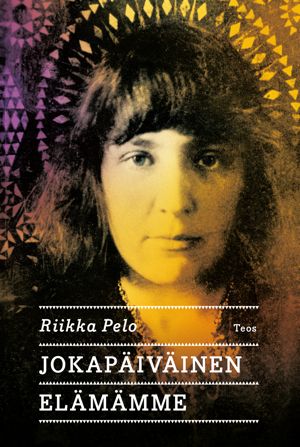 It seems that the Finlandia Prize does, as intended, have a strong influence in book sales. In December, a novel about the Russian poet Marina Tsvetaeva by Riikka Pelo, Jokapäiväinen elämämme (’Our everyday life’), which won the fiction prize in December, reached number one on the list of best-selling Finnish fiction.
It seems that the Finlandia Prize does, as intended, have a strong influence in book sales. In December, a novel about the Russian poet Marina Tsvetaeva by Riikka Pelo, Jokapäiväinen elämämme (’Our everyday life’), which won the fiction prize in December, reached number one on the list of best-selling Finnish fiction.
The next four books on the list – compiled by the Finnish Booksellers’ Association – were the latest thriller by Ilkka Remes, Omertan liitto (‘The Omerta union’), a novel Me, keisarinna (‘We, the tsarina’), about the Russian empress Catherine the Great by Laila Hirvisaari, a novel, Hägring 38 (‘Mirage 38’), by Kjell Westö, and a novel, Kunkku (‘The king’), by Tuomas Kyrö.
The winner of the Finlandia Prize for Non-Fiction, Murtuneet mielet (‘Broken minds’), about the mentally crippled Finnish soldiers in the Second World War, also did well: it was number two on the non-fiction list. (Number one was a book about a Finnish actor and television presenter, Ville Haapasalo, who trained at the theatre academy in St Petersburg and became a film star in Russia.)
The ten best-selling books for children and young people were all Finnish (and written in Finnish): it seems that this time the buyers of Christmas presents favoured books written by Finnish authors.
